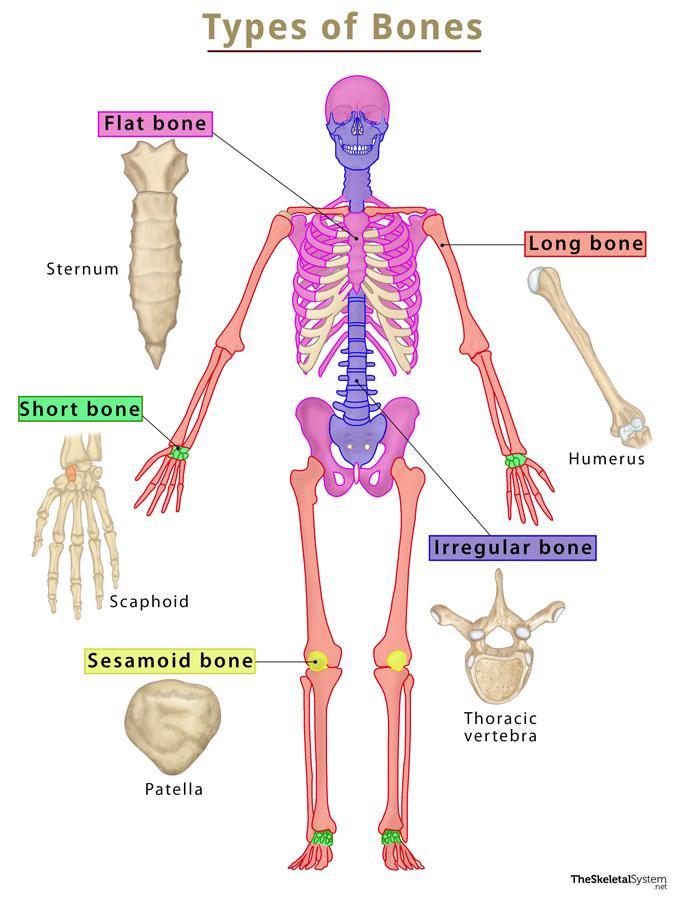Types of Bones
The human skeleton is made up of 206 bones in total. These bones are classified into several categories based on their shape and structure.
All these bones work together to form the basic framework of the human body, support the body’s weight, allow movement, and protect all the internal organs.
Different Types of Bones in the Human Body
As mentioned above, there are the following 5 primary types of bones in the human body, based on their shape: 1) long bones, 2) short bones, 3) flat bones, 4) irregular bones, and 5) sesamoid bones. Here is a graphical chart showing all the bones in the skeletal system, according to their type:
Learn what these bones are and how they are different from each other:
1. Long Bones
As the name implies, these bones are longer than wide, having a cylindrical shape. They have a long central shaft, called diaphysis, and two bulky ends called epiphyses. These are mostly the bones in the appendicular skeleton.
Functions:
- Supporting body weight
- Working as levers to facilitate movement
Examples: The upper limb bones, humerus, radius, ulna; lower limb bones, tibia, fibula, femur; the metacarpals, metatarsals, phalanges of both fingers and toes, and the clavicles
2. Short Bones
Smaller cube-shaped bones have more or less similar lengths and widths. Short bones have a layer of compact bone covering a large area of spongy bone and marrow, which makes the bones have a cuboid shape.
Functions:
- Providing stability
- Allowing movement (to some extent)
Examples: Carpal bones (scaphoid, lunate, triquetral, hamate, capitate, trapezoid and trapezium); Tarsal bones (calcaneus, talus, navicular, cuboid, lateral cuneiform, intermediate cuneiform, and medial cuneiform)
3. Flat Bones
These bones are thin, broad, and usually curved. They are typically found in places around delicate body organs that need extra protection and where there are a lot of muscle attachments.
Functions:
- Protecting vital organs, such as the heart, brain, and urinogenital organs
- Providing broad surfaces for muscle attachment
Examples: Most cranial bones (occipital, parietal, frontal, lacrimal, vomer), the scapula, ribs, and sternum
4. Irregular Bones
As the name suggests, these bones do not have a definite shape like the previous three types. As a result, they have been classified into a separate category. These bones can have relatively complex shapes that allow them to protect internal organs.
Functions:
- Protecting internal organs
Examples: All 33 vertebrae, pelvic bones (ilium, ischium, and pubis), the cranial bones, sphenoid and ethmoid
5. Sesamoid Bones
This classification is based more on the position of a bone than its shape, as these bones develop embedded in tendons. They are usually found at the ends of long bones and are shaped like sesame seeds, hence the name.
Functions:
- Protecting the tendons from regular wear and tear by reducing friction
Examples: The 2 patellae (kneecaps) and the pisiform bones in the carpus
Note: There is another particular type of bone called the sutural bone found in some people. Though categorized as bones, they are extra bony pieces found between some sutures in the skull. Their shape and position may vary from one individual to another.
Since they are not found in every human body, they are not included in the primary 206 bones, and sutural bones are not one of the primary types.
These bones appear randomly and do not usually have names. Wormian bones, sometimes found embedded in the cranial suture in a child’s skull, can be considered an example of sutural bones.
References
- Classification of Bones — Training.seer.cancer.gov
- Bones — Kenhub.com
- Types of Bone — Courses.lumenlearning.com
- Bone Classification — Opentextbc.ca
- Bone Shape Classifications — Bio.libretexts.org
- Bones — Betterhealth.vic.gov.au
- The Long and the Short of It: The Five Types of Bones — Visiblebody.com


